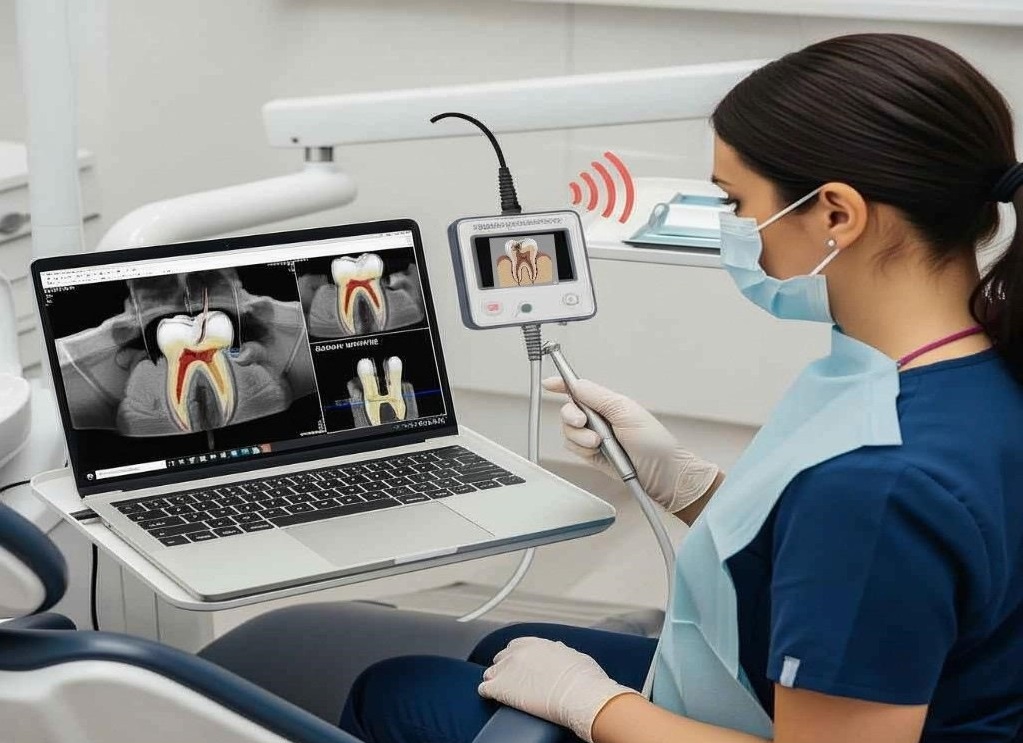

As a dentist with an interest in endodontics, I've always found the access cavity preparation as the most challenging step in Root Canal Treatment. Locating the exact position of the orifice is particularly tricky in case of posterior teeth.
Sometimes I end up over-preparing cavities in search of the canals. Other times, I miss them, particularly the MB2 canal in the upper molar.
But what if we could use CBCT and AI to design an ideal access cavity pathway tailored for each tooth? With an AI-powered airotor, it can be made easier by connecting a device to a handpiece which will guide the right path to the orifice.
The common problem in root canal treatment is mentally visualizing the access cavity and finding them. We locate the canals based on the anatomy that the textbooks guide. But individual teeth vary in size, shape and form making it difficult to know the exact location of canals.
This leads to:
? Excessive preparation
? Missed canals
? Increased chair time and operator fatigue.
Even with magnification tools like endodontic microscopes, predicting internal anatomy is still partly a guessing game. A well-designed access cavity is the first success step of an endodontic procedure.
Imagine this:
? You upload a CBCT scan of the tooth.
? An AI software analyzes the internal morphology, locates the canal orifices, and maps the ideal access pathway.
? A digital overlay of the access cavity is created which shows the depth, angle, and width needed.
? The AI in dentistry system like a canal locator syncs with your airotor or handpiece in real time.
? If you deviate from the guided path, it alerts you thus preventing iatrogenic errors.
Sound familiar?
Yes. It’s the same way as we use CBCT and surgical templates in implant placement. And it's similar to the apex locator which locates the canals to the canal locator which locates the roof of the pulp chamber.
Recent studies and ongoing research have explored AI-based guidance systems for access cavity design using CBCT and intraoral scanning. All we need to do is combine it with software which helps the airotor locate them in real time.
FEATURE/ PURPOSEAPEX LOCATORCANAL LOCATORGOALDetermine the apex or end point of root canal treatmentDetermine the pulp chamber and guides access pathTECHNOLOGYElectrical resistance between canal and periodontal ligament to find apical construction.CBCT + AI + 3D tooth morphology mapping to determine roof of the chamber.FUNCTIONAlerts when closer or beyond the apex.Alerts when deviated from the roof of the chamber.BENEFITPrevents over-instrumentation or perforation.Prevents missed canals, over-preparation, and wrong angulation.LIMITATIONCannot locate canals or assist in access.Relies on high-quality CBCT, AI training, and tech integration.
Once AI in dentistry gets all the necessary details it designs virtual pathways for your access. A software calculates the ideal angulation, depth and entry point.
Airotor is synced to follow the path with auditory feedback if deviated.

? Minimally invasive access can be achieved thus preserving the remaining tooth structure.
? Lower chances of missed canals hence lower chances of RCT failure and revisits.
? Increases confidence in beginners, making it more approachable.
? Student friendly model for easy learning, so that they can train themselves at college itself.
? Safe and best outcomes when AI comes into picture.
? High cost of integration
? Need for training the clinicians
? Ethical and data privacy concerns.
? Technical difficulties in bringing up a model
What if the handpiece itself could navigate like a guidewire in an artery for stent placement? Or AI in dentistry could design canal-shaping protocols based on real-time anatomy? This helps in the next step of RCT which involves cleaning and shaping. It can help in proper removal of bacterial debris from the canal space.
This isn't just imagination - It could be the next endodontic innovation.
AI + CBCT isn’t just the future. It is already making its way into research labs and high-tech clinics. The use of canal locators can add a great value to this system. It could help a lot of Undergraduates and dentists to start the procedure with confidence.
We are entering a world where machines don’t assist but enhance our efficiency.
“Precision is power and AI makes it predictable.”
? Do you think your endodontic procedure can make near 100% success. Yes, it is possible through AI powered airotor.
? Minor errors like missed canals, over-preparation, or iatrogenic damage can be significantly reduced.
? AI + CBCT can pre-design the ideal access cavity which can be used in design of AI powered handpiece.
? This approach can reduce guesswork and maximize conservation of tooth structure.
? Guided access can help reduce chairside stress, especially during complex cases.
? AI doesn’t replace the dentist. It assists and guides, just like a GPS in an unfamiliar city and as an auto pilot mode in Tesla cars.
? Guided Access cavity preparation and AI powered handpiece can help practitioners perform accurate, minimally invasive access.
? It is especially useful for general practitioners and students to perform the procedure without any errors.
? It is especially beneficial in cases with calcified canals, anatomic variations, or deeply buried orifices that are difficult to locate manually.
? Just like implant guides and apex locators, this can give access guides and canal locations.
? Real-time feedback, like beeps or vibrations when deviating from the ideal path can prevent perforations.
? This approach is time-saving, reproducible making it a true game-changer in dental practice.
Dr. G. Lakshmi Barathi is a dentist and medical writer with a keen interest in patient education and creative health communication. With clinical experience and a growing digital presence, she now crafts content that bridges the gap between technical knowledge and real-world understanding—especially for students and early-career professionals. When not writing, she’s likely sketching dental doodles or designing brochure.
scanO is an AI ecosystem transforming oral health for patients, dentists, corporates, and insurers worldwide

© 2025 Trismus Healthcare Technologies Pvt Ltd